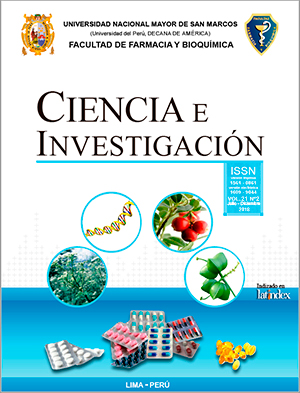Effect of biofertilizer azotobacter-rhizobium on tarwi (Lupinus mutabilis SWEET.), as an alternative to chemical fertilization
DOI:
https://doi.org/10.15381/ci.v21i2.15855Keywords:
Rhizobium; Azotobacter; Lupinus mutabilis Sweet.; Biological nitrogen fixation (BNF)Abstract
The objective of the research was to evaluate the effect of the azotobacter-rhizobium biofertilizerin Lupinus mutabilisSweet “tarwi”, as an alternative to chemical fertilization. Rhizobium sp and Azotobacter sp. strains were isolated from bean nodules and agricultural lands of the UNALM (Universidad Nacional Agraria La Molina). After a selection, they were for-mulated and applied as bacterial biofertilizers in seeds and seedlings of tarwi. Results at laboratory level showed the best treatment with Azotobacter sp. with 70% germination, superior to the water treatment (negative control) with 42% of ger-mination. In addition, the dry biomass after treatment with Rizo 1 strain (Rhizobium sp.) was superior to potassium nitrate (N +) after 20 days of evaluation. At the greenhouse level, there were statistically significant differences in the root length (LR) parameter between the Azotobacter sp treatment and the water. As well as, Azotobacter sp and N +, in the root dry weight (RDW). The results allow concluding that the investigated biofertilizers show a good promoter effect on germination and development of tarwi plants, therefore it would be consider a great potential for application to diverse crops of interest in replacement of chemical fertilization.
Downloads
Published
Issue
Section
License
Copyright (c) 2019 Mario Alcarraz, Erika Gonzales, Américo Castro, Sheilla Casas

This work is licensed under a Creative Commons Attribution-NonCommercial-ShareAlike 4.0 International License.
LOS AUTORES RETIENEN SUS DERECHOS:
- Los autores retienen sus derechos de marca y patente, y tambien sobre cualquier proceso o procedimiento descrito en el artículo.
- Los autores retienen el derecho de compartir, copiar, distribuir, ejecutar y comunicar públicamente el articulo publicado en la Revista Ciencia e Investigación (por ejemplo, colocarlo en un repositorio institucional o publicarlo en un libro), con un reconocimiento de su publicación inicial en la Revista Ciencia e Investigación.
- Los autores retienen el derecho a hacer una posterior publicación de su trabajo, de utilizar el artículo o cualquier parte de aquel (por ejemplo: una compilación de sus trabajos, notas para conferencias, tesis, o para un libro), siempre que indiquen la fuente de publicación (autores del trabajo, revista, volumen, numero y fecha).






